|
|
General: FATIMA=PYRAMID OF GIZE=DAY S MARY MAGDALENE=154 DAYS (22*7 DAYS)
Choisir un autre rubrique de messages |
|
Réponse |
Message 1 de 203 de ce thème |
|
13/5-13/10=154 days=22*7 days (22/7=day of mary magdalene)=2*11*7 (nexus 911)
22/7=3.14
FATIMA=PYRAMID OF GIZE=DAY S MARY MAGDALENE
Iglesia de Santa María Madalena, Isla do Pico
Admira la Iglesia de Santa María Madalena en Madalena, Isla do Pico, Azores.
 Iglesia de Santa María Madalena © Carlos Luis M C da Cruz La Iglesia de Santa María Madalena se encuentra localizada en el casco histórico de Madalena, la capital de la Isla do Pico del archipiélago de las Azores, Portugal.
Se trata de un templo del siglo XVII, el más grande de la isla. Cuenta con dos hermosas torres gemelas coronadas por agujas de base hexagonal y decorativa peineta con un reloj del siglo XIX.
Su interior barroco presenta una serie de azulejos historiados, imágenes religiosas, y dos altares laterales y una capilla mayor con una tallas doradas
Más información:
Ubicación:
Largo Cardenal Costa Nunes, Madalena, Isla do Pico, Azores.
|
|
|
|
Réponse |
Message 189 de 203 de ce thème |
|
|
|
|
Réponse |
Message 190 de 203 de ce thème |
|
|
|
|
Réponse |
Message 191 de 203 de ce thème |
|
|
|
|
Réponse |
Message 192 de 203 de ce thème |
|
|
|
|
Réponse |
Message 193 de 203 de ce thème |
|
|
|
|
Réponse |
Message 194 de 203 de ce thème |
|
CLEOPHAS/LEO/LEONARDO DA VINCI/LEON DE LA TRIBU DE JUDA/DAVID
C=LUNA CRECIENTE
|
|
|
|
Réponse |
Message 195 de 203 de ce thème |
|
|
|
|
Réponse |
Message 196 de 203 de ce thème |
|
|
|
|
Réponse |
Message 197 de 203 de ce thème |
|

QUEST OF THE CARIBBEAN ™
For the entire 15th century, a prophecy had circulated that “the restorer of the House of Mt. Zion will come from Spain. ” For hundreds of years, the holy sites of Jerusalem had been held captive by the Muslims. But according to ancient prophecy, that day would soon end. And Columbus believed he would be part of making it happen. In his a pursuit, and beyond doubt, Columbus sailed to fulfill a religious quest. Columbus’s voyages were intense religious missions. He saw them as the fulfillment of a divine plan for his life—and for the soon-coming end of the world. As he put it in 1500, “God made me the messenger of the new heaven and the new earth of which he spoke in the Apocalypse of St. John [Rev. 21:1] after having spoken of it through the mouth of Isaiah; and he showed me the spot where to find it. ”
Columbus thought that Ferdinand and Isabella were God’s chosen instruments to recapture Jerusalem and place the Holy City under Christian control. This was not some sidelight in Columbus’s mind; it was a central passion. As scholar Pauline Moffitt Watts has written, “This was Columbus’s ultimate goal, the purpose of all his travels and discoveries—the liberation of the Holy Land. ” The Crusaders Book of Secrets, written in the early fourteenth century, said it would take 210,000 gold florins to mount a new crusade. If Columbus could find enough gold in the Indies especially if he could find the lost mines of Solomon, which were known to be in the East—he could pay for a Holy Land crusade. That is what started his quest...
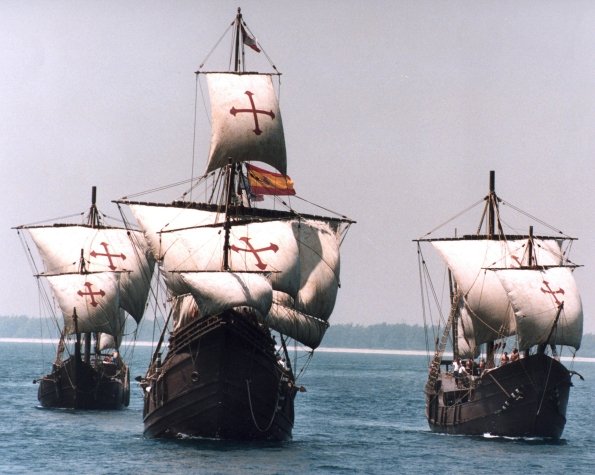 |
The Knights Templar by the end of the 14th century had established effectively an monarch, an international identity with its head, the Grand Master, exercising the role of sovereignty. Having established a system of banking from England to the Levant, vast agricultural holdings, and a military and naval force, the people of their communities enjoyed relative peace, better nutrition and ability to travel.
The King of France sought to plunder their wealth by an infamous inquistion that began on Friday the 13th, 1307. By 1312, a complicit Pope ordered the dissolution of the Order, and Europe plunged into strife and famine. The Black Death, also known as the Great Plague, was one of the most devastating pandemics in human history, resulting in the deaths of an estimated 75 to 200 million people in Eurasia and peaking in Europe from 1347 to 1351. People began looking for religous freedom, new lands, adventure, and food. The completed conquest of Granada was the context of the Spanish voyages of discovery and conquest (Columbus got royal support in Granada in 1492, months after its conquest), and the Americas—the "New World"—ushered in the era of the Spanish and Portuguese colonial empires. The antillean isles would quickly follow...
|
During the Age of Discovery, the conquistadors were Knights that sailed beyond Europe to the Americas, Oceania, Africa and Asia, claiming territory and opening trade routes. They colonized much of the world for Britain, Spain, the Dutch Republic, and Portugal in the 16th, 17th and 18th centuries. In what has become known as the Columbian Exchange, Columbus’ voyages enabled the exchange of plants, animals, cultures, ideas (and, yes, disease) between the Western and Eastern Hemispheres. Once the Europeans were able to reach nearly all parts of the globe, a new modern age would begin, transforming the world forever.
Much has been published of Columbus' connections with the Knights Templar. He was married to a daughter of a former Grand Master of the Knights of Christ, a Portuguese order that had emerged after the Templars had been driven underground. It's been noted as significant that Columbus navigated ships whose sails carried the distinctive Red Cross 'patte' of the Templars.
Christopher Columbus was looking for a western route to the Orient, and he carried with him letters of introduction to the Great Khan of China. His mission was to convince the Great Kahn to join forces and reclaim Jerusalem under the Christian Flag. All of the significant Caribbean islands were first discovered by Knights (and Conquistadors) from Europe. Most people think in terms of the “Crusades” having been conducted in the Holy Land of Jerusalem from the eleventh through the thirteenth centuries. However, the Crusades actually continued throughout the sixteenth century into the New World.
Effectively, the crusades of the Americas were founded by the same religious, military Orders for the very reason of executing plans to explore the world, make contact with the Great Khan and mobilize an army to retake Jerusalem. Christopher Columbus and his voyages were backed and financed by the Brotherhood and the Church of Rome, with his ships' sails bearing Red Cross on a white background, the symbol of the Knights Templar.
The Hospitaller colonization of the Americas occurred during a 14-year period in which the Knights of St. John (Knights of Malta) possessed four Caribbean islands: Saint Christopher, Saint Martin, Saint Barthélemy, and Saint Croix.
The Knights' presence in the Caribbean grew out of their order's close relationship with the French nobility and the presence of many members in the Americas as French administrators. The key figure in their brief colonization was Phillippe de Longvilliers de Poincy, who was both a Knight of St. John and governor of the French colonies in the Caribbean. Poincy convinced the Knights to purchase the islands of the Lesser Antilles from the bankrupt Compagnie des Îles de l'Amérique in 1651 and remained to govern them until his death in 1660. During this time, the Order acted as proprietor of the islands, while the King of France continued to hold nominal sovereignty.
Poincy was not only a naval admiral, but also an agronomist. He established the successful cultivation of sugar cane and by the end of the 17th century, St. Christopher and Nevis' exports of 'white gold' would exceed the gross products of the entire continental america. Spain plundered only for gold, while the rest of Europe sought stabile colonization and establishment of the New Jerusalem. The world's most beautiful tree, the Royal Poinciana, would later be named after him. Sir Poincy established the most beautiful estate, La Fontaine, known in the Caribbean with least assistance from mother France. The colonists of France in Britian were largely left to fend on their own. Each island was left to create its own mini-monarch, and that would include Pirate Republics. This is a large part of the untold history of the Caribbean. Read these web pages for the corrected perspective...
http://aosj.org/quest.html
|
|
|
|
Réponse |
Message 198 de 203 de ce thème |
|
|
|
|
Réponse |
Message 199 de 203 de ce thème |
|
Actually, this is the Templar cross:
And this is the Swiss flag:
|
|
|
|
Réponse |
Message 200 de 203 de ce thème |
|
|
|
|
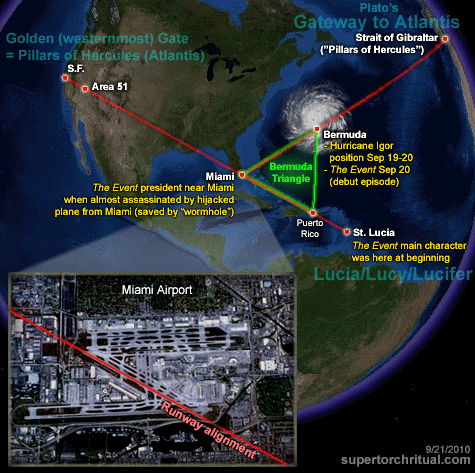
'Pillars of Hercules':
Quintessential geographical marker for Atlantis
per Plato's writings (said Atlantis lay beyond this gate)
https://www.goroadachi.com/etemenanki/updates-oct10.htm |
|
|
|
|
|
|
Réponse |
Message 201 de 203 de ce thème |
|
|
|
|
Réponse |
Message 202 de 203 de ce thème |
|
WASHINGTON D.C 77 WEST+NEW DELHI 77 EAST=154
|
|
|
|
Réponse |
Message 203 de 203 de ce thème |
|
Dimensions of the Cheops-pyramid (Khufu's pyramid)
Numbers and figures of the Cheops (Khufu) pyramid:
The pyramid of Khufu - Output / performance - Building material - Dimensions of the pyramid - Dimensions in Royal Cubits - Sources
 Cheops-pyramid (pyramid of Khufu) Cheops-pyramid (pyramid of Khufu)
Of the the famous Seven Wonders of the Ancient World the Great Pyramid of Khufu (Cheops) at Giza is the only one still standing. Even for modern men it is amazing how this man-made structure lasted so long.
The Giza pyramids must have made an incredible visual impact - at the edge of the desert three abstract geometrical symbols were rising, huge luminous white triangles reflecting the blinding light of the sun!
The pyramids on the Giza plateau are with 146.59m (Khufu / Cheops) and 143.87m (Khafre / Chefren) respectively the largest, however there are over 30 major pyramids and a myriad of smaller pyramids in Egypt.
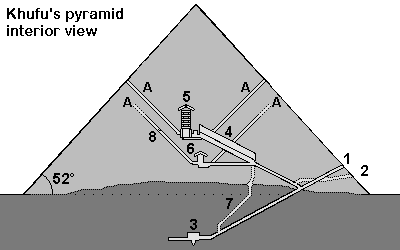
Cheops-Pyramid
1. Entrance 2. Entrance cut by grave robbers 3. Subterranean chamber 4. Grand Gallery 5. King's chamber, relieving chambers, granite portcullis slabs 6. Queen's chamber 7. Shaft 8. Limestone plugging the air shaft A= "Air shafts"
 Output / performance Output / performance
 Detailed calculations how many workers were necessary to build the pyramid Detailed calculations how many workers were necessary to build the pyramid
 Overview pyramid building Overview pyramid building
Builder
------------------- |
|
Khufu (Chuefui-Chnum or Khnum-Khuf, Cheops in Greek) during the 4th dynasty of the old kingdom |
| Time to build |
|
Probably max. 23 years (Khufu reigned from 2551 to 2528 before Christ *). Herodotus writes about 10 years of preparation and 20 years of building (details of the text) |
| Per day |
|
With 2'500'000 stones 342 stones have to be moved daily (working during 365 days a year) or 431 stones daily (working during 290 days a year). |
|
Per minute
|
|
10-hour day: every 2 minutes a stone (34 to 43 per hour)
8-hour day: nearly a stone every minute (42 to 53 stones per hour)
|
| Rule of thumb |
|
| While construction the pyramid the rate of delivery was 1 stone weighting 2.5 tons every minute. |
For our calculations we assume 500 stones a day. This is a rough estimate, assuming a 8-hour day, during 290 days a year, with 20 years to build the pyramid. Also assuming, that more time had to be used for the huge granite blocks for the King's chamber and for the more difficult upper part of the pyramid, where work went slower than in the lower parts. There probably were also other factors delaying the building of the pyramid such as the weather or a temporary shortage of certain building materials.
|
 Building materials for the Cheops-pyramid Building materials for the Cheops-pyramid
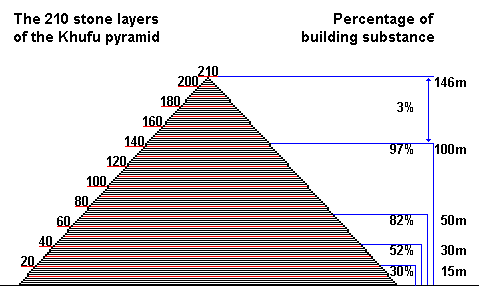
The Khufu-pyramid (Cheops) probably originally had 210 stone layers. At 50m height already 82% of the entire pyramid was built [3].
 Quarrying stones for the pyramid Quarrying stones for the pyramid
 Shipping the stone blocks down the Nile to Giza Shipping the stone blocks down the Nile to Giza
 Transporting the stone blocks using a sledge on tracks Transporting the stone blocks using a sledge on tracks
 Löhner's rope roll Löhner's rope roll
Stone blocks
------------------- |
|
2'300'000 stones |
| Casing blocks |
|
115'000 to 200'000 stones or 67'390m³ [1] |
| Total blocks |
|
2'500'000 stones |
| Stone layers |
|
Originally probably 210 stone layers, now only 201 layers [2] |
| Stone size |
|
The stone blocks usually are larger in the lower layers (1.5m = 3 cubit) and smaller in the upper layers. Most are between 1.5 and 2 cubit large (average of 127 x 127 x 71cm). 1 cubit = 0.524m - Details |
| Weight of the stone blocks |
|
With an average density of 2,6 - 2,9 t/m³ the large limestone blocks weighted 6.5 - 10 tons and the smaller ones about 1.3 tons. For all calculations on this website an average weight of 2.5 tons was used. |
| Special blocks |
|
For the King's chamber granite blocks weighting 40 to 50 tons were used |
| Total weight |
|
6'500'000 tons (average weight of a block was about 2.5 tons) |
| Pyramidion |
|
The final stone on the top was a large block in the shape of a pyramid. It was perhaps around 1.5m by 1.5m wide and 1.3m high (about 3 cubits). It was made from white Tura limestone (Turah), granite or perhaps diorite and perhaps gold plated. More information |
| Building materials |
|
Pyramid: Nummulite limestone from quarries about 200-400m south of the pyramid were used for the core stones.
Casing: light white limestone, so called Tura-limestone from quarries from the eastern shores of the Nile
King's chamber: Rose granite from Aswan 900km away
Further materials: Graywacke from the Wadi Hammamat (Eastern desert), basalt from the northern Faiyum
 Map of quarries in Egypt Map of quarries in Egypt
|
 Dimensions of the pyramid of Khufu Dimensions of the pyramid of Khufu
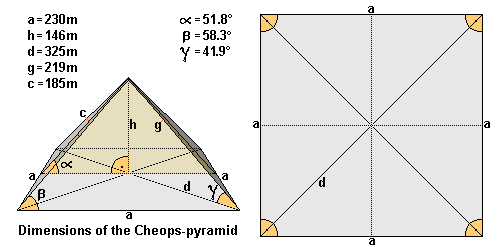
Length (a)
------------------- |
|
The average length of the edge is ~ 230.360m (230,12m = 440 cubits). Northern edge 230.328m - eastern edge 230.369m - southern edge 230.372m - western edge 230.372m. Largest difference is only 4.4cm. [3] |
| Height (h) |
|
Originally 146.59m high (= 280 cubits), the pyramid is now only 138.75m high [7] |
| Diagonal (d) |
|
325.77m |
| Ridge (g) |
|
219m |
| Height of the lateral surface |
|
186.42m |
| Pyramid angle α |
|
51° 50' 40' = inclination of the lateral surface (= 52° rounded off) [3] which corresponds to a seked of 5½ palms |
| Pyramid angle β |
|
58.3° = the two angles of the triangular lateral surface (62° = angle of the apex or tip of the pyramid) - nearly forming an equilateral triangle! |
| Pyramid angle γ |
|
41.9° = angle of the ridge |
| Corner angle |
|
Right angle base with angles from 89° 59' to 90° |
| Base area |
|
53'065.73m² |
| Superficies surface |
|
85'890.69m² |
| Pyramid volume |
|
2'592'968.43m³ including the rock core. This would be a cube with a length of 137.38m. Probable volume of stones used: 2'583'283m³ [1] or 2'326'501m³ [2]. |
| Alignment |
|
Exactly to the north (deviation only 2' 28') |
| Latitude and longitude |
|
N 29° 58’ 44.3830” latitude and E 31° 07’ 57.0194” longitude [5] |
| Altitude |
|
The base of the pyramid of Khufu lies about 60m above sea level, so the tip of the pyramid used to be on 206m above sea level [6]. |
 Alignment of the pyramids and controlling the shape of the pyramid (north-south alignment etc.) Alignment of the pyramids and controlling the shape of the pyramid (north-south alignment etc.)
 Dimensions of the pyramid of Khufu in Egyptian Royal Cubits Dimensions of the pyramid of Khufu in Egyptian Royal Cubits
 |
Length (a) |
|
440 Royal Cubits |
| Height (h) |
|
280 Royal Cubits |
| Height of the lateral surface (c) |
|
356 Royal Cubits (356.09) |
| Diagonal (d) |
|
622.25 Royal Cubits |
| Ridge (g) |
|
418.56 Royal Cubits |
| Pyramid angle α |
|
51.843° |
| Pyramid angle β |
|
58.3° |
| Pyramid angle γ |
|
41.9° |
| Corner angle |
|
90° |
It is suggested, that the Egyptians used a right angled triangle to determinate the angle of inclination of the pyramid, using the numbers a=11 and b=14 with c=17.8 (or a=22 - b=28 - c= 35.6). This determines a so called seked of 5½ palms.
 Alignment of the pyramids and controlling the shape of the pyramid (seked) Alignment of the pyramids and controlling the shape of the pyramid (seked)
 Sources Sources
[1] M. Lehner The Complete Pyramids of Egypt
[2] G. Goyon Die Cheops-Pyramide
[3] R. Stadelmann Die grossen Pyramiden von Giza
[4] F. Abitz Der Bau der grossen Pyramide mit einem Schrägaufzug
[5] GPS-coordinates of a brass disk on top of the pyramid of Khufu, Giza Plateau Mapping Project (GPMP)
[6] Maps of the Giza Plateau Mapping Project show the altitude as 60m
[7] D. Arnold Building in Egypt
* Dates according to conventional Egyptian chronology are used in this website. These are based on several list of the dynasties of pharaohs, for example the Aegyptiaca of Manetho of Sebennytos.
https://www.cheops-pyramide.ch/khufu-pyramid/khufu-numbers.html |
|
|
 Premier Premier
 Précédent
189 a 203 de 203
Suivant Précédent
189 a 203 de 203
Suivant
 Dernier
Dernier

|
|
| |
|
|
©2025 - Gabitos - Tous droits réservés | |
|
|

